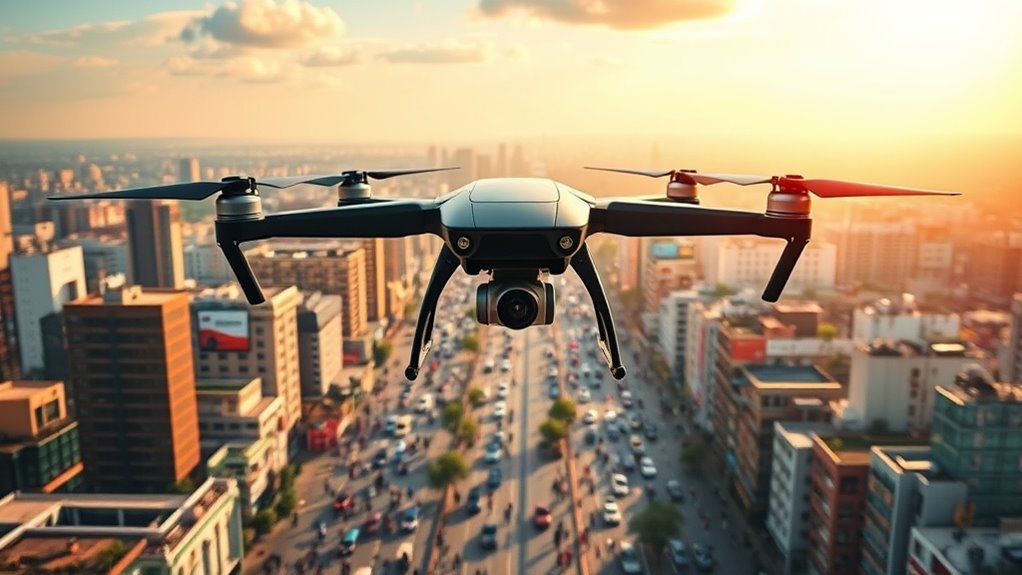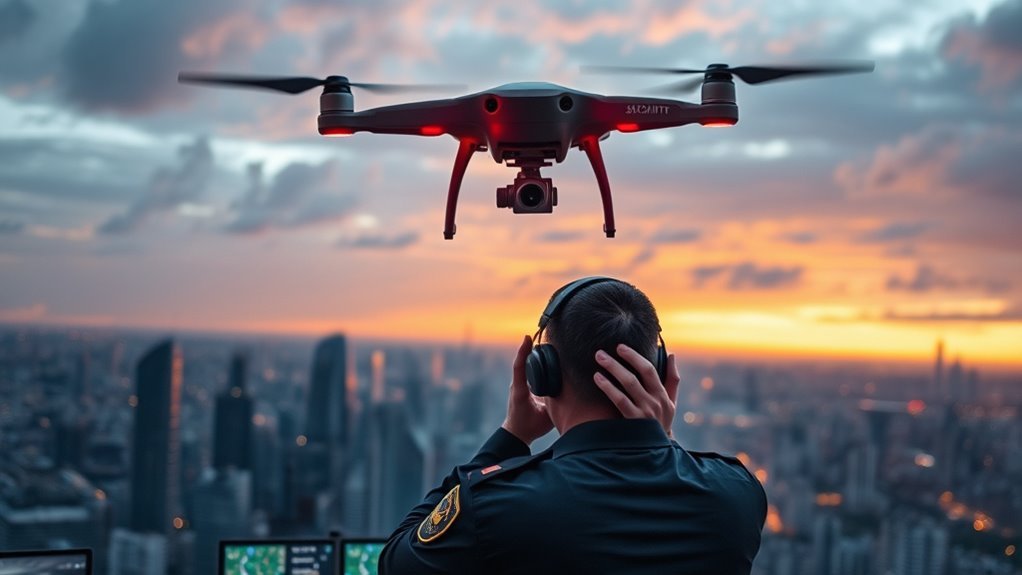You can improve your security by using drones for real-time aerial surveillance that covers large areas and reduces blind spots. They help quickly assess threats, support incident management, and track suspicious activities without heavy physical presence. Drones also enable detailed infrastructure inspections, minimizing risks and saving costs. Plus, they enhance emergency response by locating survivors and maintaining communications. These advantages make drones a powerful, flexible tool for security—explore how they transform traditional approaches.
Enhancing Surveillance Capabilities

Although traditional surveillance systems have served their purpose, drones greatly enhance surveillance capabilities by providing real-time aerial perspectives that are both flexible and expansive. With drones technology, you gain access to vantage points previously unattainable without significant infrastructure. This surveillance innovation allows for dynamic monitoring over large areas, adapting quickly to evolving situations without physical constraints. You can deploy drones swiftly, ensuring continuous data collection while minimizing blind spots common in fixed cameras. Their ability to capture high-resolution imagery and video supports detailed analysis, enhancing situational awareness. Additionally, drones reduce dependence on invasive ground patrols, aligning with your desire for security measures that respect personal freedoms. By integrating drones into surveillance frameworks, you achieve a balance between effective oversight and maintaining a less intrusive security presence.
Rapid Response and Incident Management

When you deploy drones equipped for real-time aerial surveillance, you can greatly reduce the time it takes to assess threats. This immediate data allows you to make informed decisions quickly, improving your incident management effectiveness. Integrating these capabilities guarantees your response is both swift and well-coordinated.
Real-Time Aerial Surveillance
Since rapid response is essential in security operations, real-time aerial surveillance using drones offers significant advantages for incident management. By leveraging drones technology, you gain immediate access to thorough aerial data, enhancing situational awareness and enabling informed decisions. This continuous data stream reduces response times and improves coordination among security teams, all while maintaining operational freedom.
| Feature | Benefit |
|---|---|
| Live Video Feed | Instant incident visualization |
| Thermal Imaging | Detects obscured threats |
| GPS Integration | Precise location tracking |
| Automated Flight Paths | Consistent area monitoring |
| Data Analytics | Rapid pattern recognition |
Utilizing these capabilities, you can maintain security with minimal intrusion, ensuring freedom alongside safety.
Quick Threat Assessment
How quickly can you assess a threat when seconds matter? With drones, you gain an immediate advantage in threat detection, allowing you to identify potential risks rapidly and accurately. These devices provide real-time data, enabling swift risk analysis that informs your decision-making process. By deploying drones, you’re not just reacting faster; you’re proactively managing incidents before they escalate. Their mobility and advanced sensors give you a thorough view of the situation, pinpointing hazards with precision. This rapid response capability guarantees you maintain control and protect your freedom effectively. Integrating drones into your security measures minimizes uncertainty, optimizes resource allocation, and enhances your overall incident management strategy—critical factors when every moment counts.
Securing Large-Scale Events and Crowds

When you’re managing large-scale events, real-time crowd monitoring becomes essential to identify potential risks quickly. Utilizing drones allows you to gather extensive aerial data, enabling rapid incident response before situations escalate. This approach enhances situational awareness and improves overall security effectiveness.
Real-Time Crowd Monitoring
Although managing large crowds has always posed significant challenges, real-time crowd monitoring through drones offers a transformative solution for enhancing security at major events. By integrating drone technology into your security framework, you gain immediate aerial perspectives that reveal crowd behavior patterns otherwise difficult to assess from the ground. This drone integration enables continuous surveillance without intrusive physical presence, preserving attendees’ freedom while ensuring safety. You can detect potential overcrowding, unusual movements, or emerging disturbances early, allowing for informed decision-making. Additionally, drones provide scalable coverage across vast event spaces, adapting to fluctuating crowd densities efficiently. Employing this technology objectively helps balance effective security with respect for personal liberties, positioning you to maintain order proactively without compromising the open, free environment attendees expect.
Rapid Incident Response
Building on the advantages of real-time crowd monitoring, rapid incident response becomes the next essential component in securing large-scale events. With drone technology, you gain a significant edge in incident coordination, allowing you to act swiftly and effectively during emergencies. Drones provide aerial perspectives that quickly identify threats and relay vital information to your response teams. This capability enhances situational awareness, enabling faster decision-making and resource deployment.
Key benefits include:
- Immediate threat detection from multiple vantage points
- Real-time communication between drones and ground teams
- Accelerated mobilization of emergency responders
- Reduced response times minimizing potential harm
- Efficient crowd movement guidance to prevent panic
Infrastructure Inspection and Protection
Since infrastructure plays a critical role in public safety and economic stability, inspecting and protecting it requires advanced, reliable methods. You can leverage drone inspections to conduct thorough, timely assessments of bridges, power lines, and pipelines without disrupting their operation. Drones offer precise infrastructure monitoring by capturing high-resolution images and real-time data, enabling early detection of structural weaknesses or damage. This proactive approach helps prevent failures that could compromise freedoms tied to safety and mobility. Additionally, drones reduce the need for dangerous manual inspections, enhancing worker safety. By integrating drone technology, you maintain continuous surveillance with minimal intrusion, aligning security efforts with your values of autonomy and efficiency. Ultimately, drone inspections empower you to safeguard critical assets while preserving operational freedom and public trust.
Border and Perimeter Security
When securing borders and perimeters, drones provide an unmatched combination of real-time surveillance and rapid response capabilities. You can enhance border control and perimeter monitoring with aerial vantage points that cover large, inaccessible areas efficiently. Drones improve detection accuracy while reducing manpower needs. Key advantages include:
- Continuous, automated patrols without fatigue
- Integration with sensors for thermal and motion detection
- Immediate data transmission to command centers
- Flexible deployment in remote or rugged terrain
- Cost-effective scalability compared to traditional methods
Disaster and Emergency Support
Beyond border security, drones play a significant role in disaster and emergency support by providing rapid situational awareness and facilitating timely decision-making. You can rely on drones to assess damage, locate survivors, and relay real-time data to emergency responders, enhancing disaster recovery efforts. Their ability to maintain emergency communication, even when traditional networks fail, guarantees coordinated responses. Here’s a clear overview:
| Function | Benefit | Example Use Case |
|---|---|---|
| Aerial Damage Survey | Quick damage assessment | Post-hurricane infrastructure checks |
| Survivor Location | Precise, rapid identification | Searching collapsed buildings |
| Emergency Communication | Network restoration | Temporary communication hubs |
| Resource Delivery | Swift provision of supplies | Delivering medical aid in remote zones |
Crime Prevention and Law Enforcement Assistance
Although crime prevention has traditionally relied on ground patrols and surveillance, drones have become invaluable tools for law enforcement agencies. You’ll find that their technological integration enhances real-time monitoring and rapid response without intrusive presence. Drones foster community engagement by transparently supporting public safety efforts while respecting civil liberties. Their capabilities include:
- Providing aerial reconnaissance to identify suspicious activities quickly
- Assisting in tracking and apprehending suspects with minimal risk
- Monitoring large gatherings to prevent disorder without heavy police footprint
- Gathering evidence in hard-to-reach or hazardous locations
- Supporting search and rescue operations efficiently
Cost-Effective and Scalable Security Solutions
The advantages drones provide in law enforcement extend into offering cost-effective and scalable security solutions. When you rely on drones for affordable monitoring, you reduce the need for extensive physical patrols, cutting personnel and equipment expenses considerably. Drones can be deployed flexibly across different areas, allowing you to scale surveillance efforts up or down based on real-time needs without additional infrastructure costs. This adaptability supports a security approach that respects individual freedoms by focusing on efficiency rather than intrusive presence. Furthermore, integrating drones with existing systems enhances coverage and response capabilities while maintaining budget discipline. By choosing scalable solutions, you guarantee your security measures evolve alongside emerging threats and community demands, achieving a balance between effective oversight and cost management.

